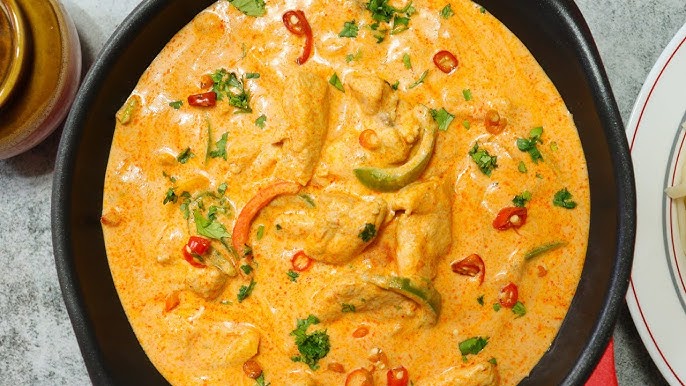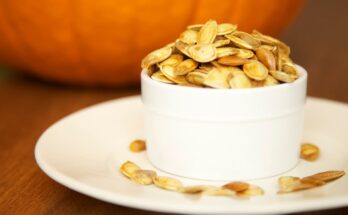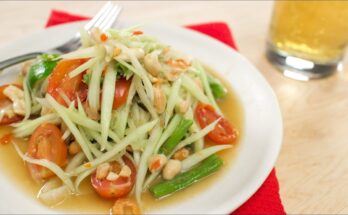Thai Chicken Curry Recipe: Thai curry isn’t just a dish—it’s a story of culture, tradition, and flavor, all simmered into one aromatic bowl. Born in the heart of Southeast Asia, Thai curry has roots that trace back centuries, influenced by neighboring cuisines like Indian and Chinese. Over time, Thai cooks developed their own distinctive take on curry, emphasizing fresh herbs, coconut milk, and that signature balance of spicy, sweet, sour, and salty.
What sets Thai curry apart is its use of freshly pounded curry pastes. Unlike dry spice mixes in Indian curries, Thai curry pastes often include ingredients like lemongrass, galangal, kaffir lime, garlic, and shrimp paste. These aren’t just flavor enhancers—they’re the very soul of the dish. Each region of Thailand offers its own version of curry, and while red and green curry are more popular globally, yellow curry has its own creamy charm.
In Thailand, curry is more than just food; it’s a daily delight. Whether enjoyed with family at dinner or picked up as a quick lunch from a street vendor, Thai curry brings people together. It reflects a philosophy of harmony—in flavor, in preparation, and in the way it’s shared.
Why Thai Chicken Curry is a Must-Try Dish
So why should Thai chicken curry be on your dinner rotation? For starters, it’s one of the most comforting dishes you’ll ever eat. Imagine tender chicken soaked in a silky, spiced coconut gravy that warms you from the inside out. Add to that the fragrant herbs, the soft bite of bell peppers or bamboo shoots, and a mound of steaming jasmine rice—and you’ve got a meal that hits every note.
This dish is also highly customizable. Want it spicier? Add more chilies. Prefer it mild? Tone it down with extra coconut milk. It suits every palate and dietary need, which makes it a go-to recipe for family dinners, meal preps, or even dinner parties where you want to impress without stressing.
Most importantly, it’s a fantastic introduction to Thai cooking. If you’re new to Southeast Asian cuisine, Thai chicken curry offers a beginner-friendly experience that teaches you how to blend spices, cook with coconut milk, and explore exotic ingredients in a familiar way.
Ingredients You’ll Need
Core Ingredients for Thai Chicken Curry
Let’s get down to the essentials. Thai chicken curry doesn’t require a mile-long ingredient list, but what you use matters. Here are the key components:
- Chicken: Boneless, skinless chicken thighs are best. They’re tender, juicy, and soak up the curry flavors well.
- Thai curry paste: Choose red, green, or yellow based on your flavor preference. Red is bold and spicy, green is herbal and vibrant, and yellow is milder with a touch of sweetness.
- Coconut milk: The rich, creamy base of the curry. Go for full-fat canned coconut milk for the best texture and flavor.
- Vegetables: Bell peppers, bamboo shoots, carrots, and zucchini are all great choices. Use what’s fresh and in season.
- Fish sauce: Adds umami depth and a hint of saltiness.
- Brown sugar or palm sugar: Balances the heat and salt with a touch of sweetness.
- Kaffir lime leaves (optional but highly recommended): Adds a citrusy aroma that elevates the dish.
- Basil leaves: Thai basil if you can find it; otherwise, sweet basil will do.
- Oil: For frying the curry paste—use vegetable or coconut oil.
- Salt and pepper: To taste.
Optional Ingredients for a Flavor Twist
Want to make your curry your own? Here are a few extras that can transform your dish:
- Pineapple chunks: Adds a sweet-tart contrast that works beautifully with yellow curry.
- Chilies: For those who like it hot—bird’s eye chilies will take the spice level up a notch.
- Lime juice or zest: Adds brightness at the end.
- Peanuts or cashews: For a bit of crunch.
- Tofu or mushrooms: Perfect for vegetarians or to stretch the meal.
Ingredient Substitutions and Dietary Alternatives
No access to authentic Thai ingredients? No worries. Here are some practical swaps:
- Chicken: Use tofu or tempeh for a vegetarian version.
- Fish sauce: Swap with soy sauce or tamari for a vegetarian/gluten-free option.
- Coconut milk: Light coconut milk works if you’re watching calories, though the flavor will be slightly thinner.
- Thai basil: Italian basil can work in a pinch.
If you’re on a low-carb or keto diet, simply reduce the sugar and serve the curry with cauliflower rice instead of jasmine rice.
Kitchen Tools and Utensils Required
Basic Tools You’ll Need
You don’t need a fancy kitchen setup to whip up a fantastic Thai chicken curry. Here are the basics:
- Large skillet or wok: Ideal for high-heat cooking and even heat distribution.
- Sharp knife: For chopping chicken and vegetables.
- Cutting board: Preferably separate boards for meat and vegetables.
- Wooden spoon or spatula: Helps stir and scrape the pan without damaging non-stick surfaces.
- Measuring spoons and cups: Precision matters when balancing flavors.
Handy Add-ons for Efficiency
These aren’t must-haves, but they’ll make your cooking smoother:
- Garlic press: Speeds up prep time.
- Microplane grater: Perfect for zesting lime or grating fresh ginger.
- Blender or food processor: If you want to make your own curry paste.
- Rice cooker: For perfectly fluffy rice every time.
Prepping Before You Cook
How to Prepare Your Ingredients
Before you even light the stove, prepping is key. Chop your chicken into bite-sized pieces so it cooks evenly and quickly. Slice your vegetables thinly for better texture and faster cooking. Open your cans, measure your liquids, and have everything ready in bowls—this makes cooking much smoother.
Marinating Chicken for Deeper Flavor
Want next-level curry? Marinate your chicken. Even 15–30 minutes in a mix of curry paste, fish sauce, and lime juice can make a huge difference. The marinade not only flavors the meat from the inside but also tenderizes it, making every bite juicy and delicious.
Step-by-Step Guide to Cooking Thai Chicken Curry
Step 1 – Heating the Oil and Curry Paste
Start by heating 1–2 tablespoons of vegetable oil in a large pan or wok over medium heat. Add 2–3 tablespoons of Thai red curry paste and stir-fry for 1–2 minutes until fragrant. This step blooms the spices and deepens the flavor.
Step 2 – Cooking the Chicken to Perfection
Add sliced chicken breast or thighs to the pan. Stir and cook for about 4–5 minutes, until the chicken turns opaque and starts to brown slightly.
Step 3 – Adding Coconut Milk and Simmering
Pour in 1 can (400ml) of coconut milk, stirring well to combine with the curry paste. Bring to a gentle simmer and cook for 10 minutes to let the flavors meld beautifully.
Step 4 – Tossing in the Vegetables
Add bell peppers, bamboo shoots, zucchini, or your favorite vegetables. Cook for another 5 minutes, keeping the veggies slightly crisp.
Step 5 – Final Seasoning and Garnishing
Stir in fish sauce, brown sugar, and lime juice to balance saltiness and sweetness. Garnish with fresh basil or cilantro. Serve hot with steamed jasmine rice for the perfect Thai comfort meal.
Tips for the Perfect Thai Chicken Curry
How to Balance Flavors like a Thai Chef
The heart of Thai cooking lies in its balance—spicy, sweet, sour, salty, and umami must all sing together. Here’s how to strike that perfect harmony:
- Too spicy? Add more coconut milk or a bit of sugar.
- Too salty? A squeeze of lime juice or a touch of sugar can mellow it out.
- Too bland? Try more fish sauce or a pinch of salt.
- Lacking depth? A teaspoon of tamarind paste or soy sauce can bring it to life.
Always taste as you go. Thai cooking is an intuitive process—feel free to tweak ingredients to match your personal palate.
Fixing Common Mistakes
- Curry too watery? Simmer it longer uncovered to reduce and thicken the sauce.
- Chicken dry or chewy? Avoid overcooking it during the browning stage. Thighs are more forgiving than breast meat.
- Vegetables mushy? Add them later in the process to keep them crisp.
- Overwhelmed by spice? A little sugar or serving with extra rice helps tame the fire.
Don’t be afraid to experiment. Thai curry is forgiving, flexible, and fun—just follow the steps, and you’ll be a curry master in no time.
Serving Suggestions
What to Serve with Thai Chicken Curry
The best companion to Thai chicken curry? Without a doubt, steamed jasmine rice. Its delicate floral aroma and soft, sticky texture soak up the rich curry sauce like a dream.
But if you’re in the mood to switch things up, here are a few alternatives:
- Sticky rice: Especially great with a thicker yellow curry.
- Brown rice: Adds a nutty flavor and extra fiber.
- Cauliflower rice: Low-carb and keto-friendly.
- Flatbreads or naan: Not traditional, but great for scooping up every last bit.
You can also serve the curry over rice noodles for a Thai-style noodle bowl, or even with quinoa for a healthy twist.
Presentation Ideas for a Restaurant-Style Meal
Want to make your Thai curry look as good as it tastes? Try these simple tips:
- Use a deep, wide bowl to hold both curry and rice.
- Drizzle a swirl of coconut cream over the top for a creamy finish.
- Garnish with sliced red chilies, lime wedges, or Thai basil leaves.
- Serve with a side of cucumber salad to balance the heat.
A little effort in presentation goes a long way—especially if you’re serving guests or just treating yourself to a fancy night in.
Storing and Reheating Leftovers
Best Practices for Storage
One of the best things about Thai chicken curry? It tastes even better the next day. All those flavors get more time to mingle and deepen overnight. But to make sure your leftovers stay fresh and safe to eat, here’s how to store them properly:
- Let it cool: Don’t toss hot curry straight into the fridge. Let it cool to room temperature first (but don’t leave it out longer than 2 hours).
- Use airtight containers: Transfer the curry into sealed glass or BPA-free plastic containers. This keeps moisture and odors out.
- Label and date: It’s easy to forget how long food’s been in the fridge. A quick label helps avoid mystery meals.
- Refrigerate or freeze: In the fridge, curry lasts about 3–4 days. In the freezer, it can stay good for up to 2 months.
To freeze, you can use zip-top freezer bags laid flat to save space. Just be sure to leave a bit of room for expansion, as the curry will expand when it freezes.
Reheating Without Losing Flavor
Reheating Thai chicken curry is easy, but you’ve got to do it right to preserve the creamy texture and bold flavors.
- Stovetop method (recommended): Pour the curry into a saucepan and heat over medium-low, stirring occasionally until heated through. Add a splash of water or coconut milk if the sauce is too thick.
- Microwave method: Place in a microwave-safe bowl, cover loosely, and heat in 1-minute intervals, stirring in between. Be careful not to overheat—it can split the coconut milk.
- Avoid boiling: High heat can break the coconut milk and make the sauce oily or grainy.
Pro tip: Always taste and adjust before serving. Sometimes curry needs a little extra fish sauce, lime juice, or basil to revive it after sitting.
Health Benefits of Thai Chicken Curry
Nutritional Value of Ingredients
Thai chicken curry isn’t just delicious—it can be surprisingly nutritious. Let’s take a closer look at what’s inside:
- Chicken: A great source of lean protein that helps with muscle repair and satiety.
- Coconut milk: Contains healthy fats known as medium-chain triglycerides (MCTs), which may boost energy and metabolism.
- Vegetables: Bell peppers, carrots, and zucchini add fiber, vitamins A and C, and important antioxidants.
- Herbs and spices: Lemongrass, ginger, garlic, and turmeric all have anti-inflammatory and immune-boosting properties.
- Fish sauce: While high in sodium, it provides vital minerals and depth of flavor, so you use less salt overall.
How to Make it Healthier
If you’re watching your diet, there are plenty of ways to lighten up Thai chicken curry without compromising on taste:
- Use light coconut milk: Cuts down on calories and fat.
- Load up on veggies: Double the veggies and halve the chicken for a plant-forward meal.
- Skip the sugar: Many recipes call for a tablespoon or more—reduce or omit if you’re cutting back on added sugars.
- Go low-sodium: Use low-sodium fish sauce or substitute with tamari.
- Serve with whole grains: Swap white rice for brown rice or quinoa for extra fiber.
Want to go fully plant-based? Replace chicken with tofu or chickpeas, and use soy sauce instead of fish sauce. Easy, delicious, and still packed with flavor.
Variations of Thai Chicken Curry
Red vs Green vs Yellow Curry
If you thought all Thai curries were the same, think again. Here’s a quick breakdown of the three most popular types:
- Red Curry: Made with red chilies, garlic, galangal, and lemongrass. It’s bold, rich, and has a spicy kick.
- Green Curry: Uses fresh green chilies and Thai basil. It’s the spiciest of the bunch, with a bright, herbal flavor.
- Yellow Curry: Milder and sweeter, with turmeric giving it that golden hue. It’s creamy and often has a slightly Indian-inspired flavor due to cumin and coriander.
Each one has its own personality. If you’re just starting out, yellow curry is the most beginner-friendly, while red and green are perfect if you love heat.
Vegetarian and Vegan Alternatives
Thai chicken curry is incredibly adaptable for different diets. Here are some easy swaps:
- Tofu or tempeh instead of chicken for a meat-free version.
- Mushrooms, sweet potatoes, or eggplant add heartiness and texture.
- Vegetable stock in place of chicken broth (if used).
- Soy sauce or tamari instead of fish sauce to make it vegan.
You can even go low-carb by serving it with cauliflower rice or shirataki noodles. The curry base stays the same—you just switch up what goes in it.
FAQs about Thai Chicken Curry Recipe
How spicy is Thai chicken curry?
It depends on the type of curry paste you use. Red and green pastes are usually quite spicy, while yellow curry is milder. You can always control the heat by adjusting the amount of paste or adding extra coconut milk.
Can I make this in a slow cooker?
Yes! Sauté the curry paste and chicken first, then transfer everything to the slow cooker. Add coconut milk, veggies, and seasonings. Cook on low for 4–5 hours or until the chicken is tender.
What’s the best way to thicken Thai curry?
Let it simmer uncovered to reduce naturally. For extra thickness, add a slurry of cornstarch and water, or mash a few pieces of cooked potato into the sauce.
How long does Thai curry last in the fridge?
Properly stored in an airtight container, Thai curry lasts 3–4 days in the refrigerator. Freeze for longer storage (up to 2 months).
Is Thai curry gluten-free?
Yes, but check your ingredients. Some store-bought curry pastes and fish sauces may contain gluten. Look for gluten-free labels or make your own paste at home.
Conclusion
Thai chicken curry isn’t just a recipe—it’s an experience. From the sizzling aroma of curry paste hitting hot oil to the creamy swirl of coconut milk blending with fresh herbs and spices, every step is a dance of flavor and tradition.
Whether you’re new to Thai cuisine or a seasoned home chef, this dish delivers warmth, depth, and satisfaction every single time. It’s flexible enough to suit any taste, quick enough for weeknights, and impressive enough for guests.
So grab your wok, gather those vibrant ingredients, and get ready to bring the heart of Thailand into your kitchen. And remember: cooking is less about perfection and more about passion.



